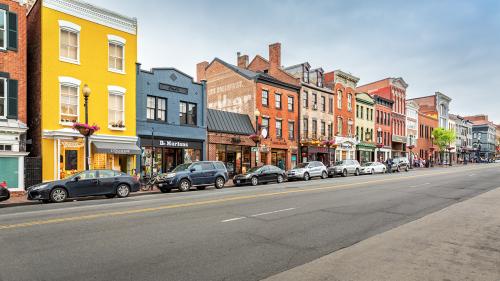The most important takeaway from President Obama’s just-released 2015 budget is actually the least discussed: Over the next decade, the federal government’s focus will change fundamentally, forcing our cities and metropolitan areas to pick up the slack.
The story of the federal government’s changing role can be found in this chart buried on page 172.
Non-defense discretionary spending—including critical investments in infrastructure, education, and innovation—will continue to drop severely, from 3.1 percent of gross domestic product (GDP) in 2013 to just 2.2 percent in 2024. When compared to an average of 3.8 percent for the last 40 years, it’s clear how dramatic an impact these cuts will have.
Meanwhile, total spending on mandatory programs will rise from 12.6 percent of GDP to 14.1 percent, an increase of almost $1.8 trillion per year.
The point is that there will be less federal funding for what our nation desperately needs to create and maintain a stronger, more competitive, job-creating economy. In response, our cities and metropolitan areas—and the networks of institutions and leaders who co-govern these communities—will need to step up and assume responsibility for key productive investments.
Three actions will be critical to ensure our national competitiveness:
First, Washington needs a smarter game plan for the scale-back, as opposed to the indiscriminate cuts imposed by the sequester.
The fact is that certain federal activities can be devolved to states and metropolitan areas, while others cannot. We need Washington to continue doing the things that metro areas can’t, such as maintaining a robust social safety net. In her 1993 book, “Reviving the American Dream,” Alice Rivlin smartly called for devolving the “productivity agenda” back to state and local governments. This work remains a blueprint for a measured, practical redistribution of responsibility.
Second, metropolitan leaders need to spend their money in smarter ways to spur productive, inclusive, and sustainable growth.
In New York City, for example, then-Mayor Michael Bloomberg invested $100 million from the municipal capital budget on infrastructure improvements for Roosevelt Island, resulting in the build-out of a new $2 billion campus of Cornell and Technion Universities, to be largely funded by private and civic resources. In Detroit, as elsewhere, philanthropic investments have been a catalytic force. The Kresge Foundation recently committed $150 million over five years to implement recommendations outlined in the Detroit Future City report, doubling down on investments it had already made to revitalize the city’s riverfront and to spur construction of the M1 Rail line connecting key parts of the city.
Finally, metro areas must develop new market mechanisms to enable innovative investments in our communities.
As federal resources dry up, local governments are already leveraging public-private partnerships to repair roads and bridges and retrofit aging water systems. Another promising model is increased use of value capture, in which public projects are financed by nearby land owners who will benefit from improved infrastructure. The Washington, D.C. Metrorail provides a key example: The NoMa station was added in 2004, with one-quarter of the $110 million construction financed by a 30-year assessment of adjacent land owners who stood to benefit from increased transit accessibility. Less than a decade later, the station has catalyzed $3 billion in private investment and land values have increased from $500 million to $2.3 billion.
In the next decade, the federal government will become a smaller and less reliable investor. Our cities and metropolitan areas—the engines of our national economy and centers of trade and innovation—will assume new and greater responsibilities. This isn’t the end of government; rather, it’s the start of a new federalism.
The Brookings Institution is committed to quality, independence, and impact.
We are supported by a diverse array of funders. In line with our values and policies, each Brookings publication represents the sole views of its author(s).



Commentary
The Hidden Line in Obama’s Budget and What it Means for Cities and Metro Areas
March 7, 2014